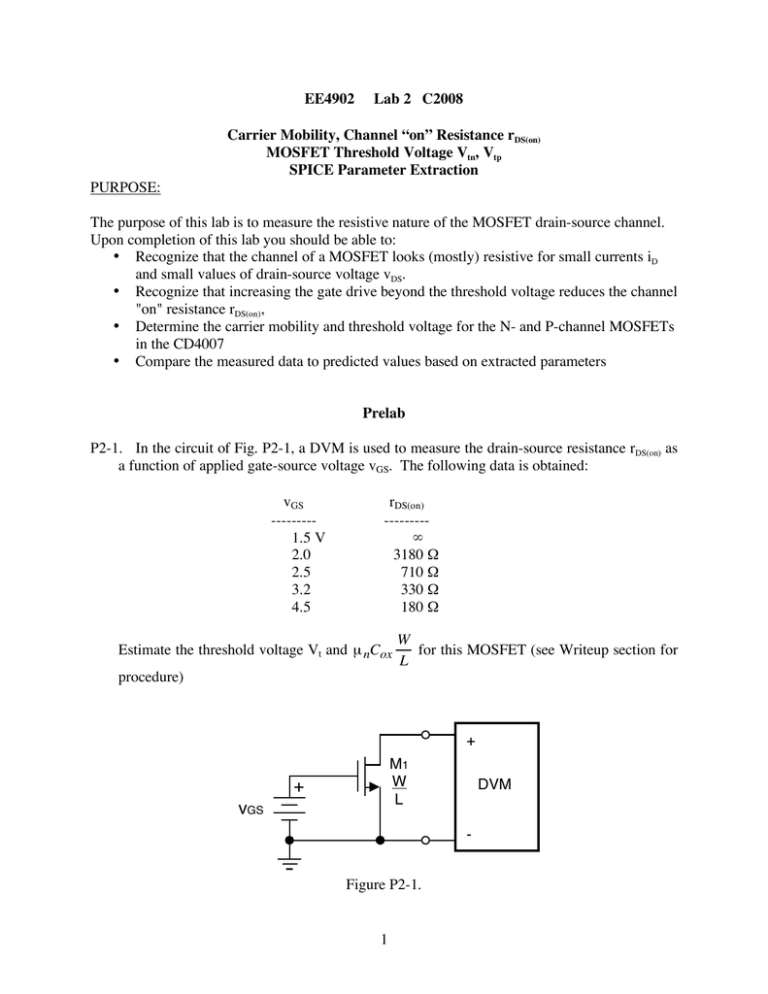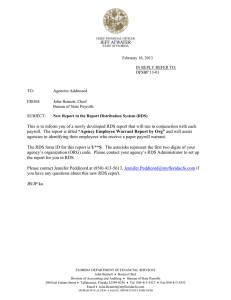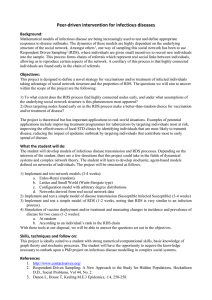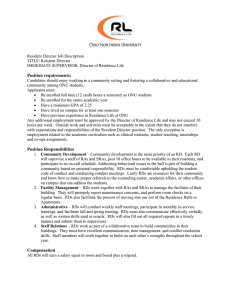1 EE4902 Lab 2 C2008 Carrier Mobility, Channel “on” Resistance
advertisement

EE4902 Lab 2 C2008 Carrier Mobility, Channel “on” Resistance rDS(on) MOSFET Threshold Voltage Vtn, Vtp SPICE Parameter Extraction PURPOSE: The purpose of this lab is to measure the resistive nature of the MOSFET drain-source channel. Upon completion of this lab you should be able to: • Recognize that the channel of a MOSFET looks (mostly) resistive for small currents iD and small values of drain-source voltage vDS. • Recognize that increasing the gate drive beyond the threshold voltage reduces the channel "on" resistance rDS(on), • Determine the carrier mobility and threshold voltage for the N- and P-channel MOSFETs in the CD4007 • Compare the measured data to predicted values based on extracted parameters Prelab P2-1. In the circuit of Fig. P2-1, a DVM is used to measure the drain-source resistance rDS(on) as a function of applied gate-source voltage vGS. The following data is obtained: vGS --------1.5 V 2.0 2.5 3.2 4.5 rDS(on) --------∞ 3180 Ω 710 Ω 330 Ω 180 Ω Estimate the threshold voltage Vt and µ nCox W for this MOSFET (see Writeup section for L procedure) + M1 W L + vGS DVM - Figure P2-1. 1 Lab Exercise: REDUCING ON RESISTANCE rDS(on) BY INCREASING GATE DRIVE vGS L2-1. Use the circuit of Fig. L2-2 (using the DVM in ohmmeter mode) to measure the on resistance rDS(on) directly. As you vary vGS, you will see variation in the on resistance. NOTE: Unfortunately, this requires lots of DVM lead swapping and button clicking – you need to measure the on resistance rDS(on) between the drain and source terminals (DVM as ohmmeter), but also the applied gate-source voltage vGS (DVM as voltmeter). Keep the DVM negative (- or black) lead attached to ground; just swap the positive (+ or red) lead. Since the currents flowing in this circuit are relatively small, you don't need to turn power off when changing the lead configuration - save time! ADDITIONAL NOTE: It's important to observe the DVM lead polarity shown in Fig. L2-2. If the DVM connection is reversed, the DVM current iDVM will forward bias the substrate-todrain diode when VGS < Vt. ANOTHER ADDITIONAL NOTE: For this part, it’s very important to leave the DVM on the 20V/20kΩ range throughout. Changing the resistance range changes the current the DVM uses to measure resistance, which affects the resistance measured in the triode region. The problem: in the 2kΩ range, the DVM injects a larger test current than in the 20kΩ range. This causes a larger value of vDS, violating the “small vDS” condition for the resistive portion of the triode region. So, even though normal practice would be to use the 2kΩ range when measuring rDS(on) less than 2kΩ (for better measurement resolution), in this case, we’ll live with lower resolution so as not to violate the “small vDS” condition. L2-2. Set the power supply voltage VSUPPLY to provide vGS of approximately +5V. Measure rDS(on) and vGS. The resistance rDS(on) should be in the range of approximately 200Ω to 1kΩ (which will read ≈ 0.2kΩ to ≈ 1kΩ with the DVM on the 20kΩ range). Reduce vGS until rDS(on) has increased by about a factor of two. Measure rDS(on) and vGS again. As vGS decreases, you should see rDS(on) increase. Continue decreasing the power supply voltage to decrease vGS in increments that approximately double the measured value of rDS(on). Measure rDS(on) and vGS at each step and make a table of measurements in your lab notebook. As vGS gets closer to the threshold voltage Vtn, rDS(on) will start increasing rapidly. As rDS(on) increases, take a few data points with rDS(on) values of about 2kΩ, 5kΩ, and 10kΩ. You should end up with a total of about 5 to 10 data points. In your lab notebook, plot rDS(on) as a function of vGS . Note that increasing gate drive vGS reduces the value of on-resistance. Also, plot 1/ rDS(on) as a function of vGS. You should see an approximately linear relationship between 1/ rDS(on) and vGS; a line through the measured data points should intersect the vGS axis at the threshold voltage. iDVM R1 10k! VSUPPLY + (RED) 8 M1 1/6 CD4007 6 R2 2k! + VGS - 7 DVM iDVM - (BLK) Figure L2-2. 2 L2-3. Repeat the above procedure for a P-channel MOSFET as shown in Figure L2-3 below. You may need to adjust your lead-swapping technique with the DVM since you will now be measuring vSG: Keep the DVM positive (+ or red) lead attached to ground; just swap the negative (- or black) lead. The range of resistances rDS(on) should be similar to the previous part; follow the same procedure for gathering data. In your lab notebook, plot rDS(on) as a function of vSG . Also, plot 1 / rDS(on) as a function of vSG. Note that, since your horizontal axis is vSG rather than vGS, some care is needed in interpreting the plots. For the P-channel MOSFET making the gate drive voltage vGS more negative reduces the value of on-resistance. On the 1/ rDS(on) plot, you should also see an approximately linear relationship between 1/ rDS(on) and vSG; however in this case a line through the measured data points should intersect the vSG axis at the negative of the threshold voltage. So, for example, if the vSG-intercept is at 2V, then the threshold voltage is -2V. iDVM + (RED) VSUPPLY R2 R1 2k! 10k! + VSG 6 14 M1 1/6 CD4007 DVM iDVM 13 Figure L2-3. 3 - (BLK) WRITEUP RELATIONSHIP BETWEEN ON RESISTANCE rDS(on) AND GATE DRIVE vGS N-Channel MOSFET W2-1. Plot rDS(on) as a function of vGS. W , and the L x-intercept (threshold voltage Vtn ) for the triode region "on" resistance expression: 1 rDS(on ) = (2-1) W µn Cox (vGS " Vt ) L W2-2. Plot 1/ rDS(on) as a function of vGS. Using this plot, extract the slope µ nCox W W2-3. From the slope µ nCox , determine the value of mobility µn. Use your value of Cox L ! from Lab 1 and the W/L = 350/10 for the CD4007. W2-4. Using your parameters from W2-2, plot the prediction of the MOSFET rDS(on) model on the same axes with your measured data from part L2-2. How well does the model predict the measured data? P-Channel MOSFET W2-5. Plot rDS(on) as a function of vSG. W2-6. Plot 1/ rDS(on) as a function of vSG. Using this plot, extract the slope µ pCox W , and the L x-intercept (which will be - Vtp , the negative of the p-channel threshold voltage) for the triode region "on" resistance expression: (2-1) 1 rDS(on ) = µ p Cox ! W v SG " ("Vtp ) L ( W2-7. From the slope µ pCox ! ) W , determine the value of mobility µp. Use your value of Cox from L Lab 1 and the W/L = 900/10 for the CD4007. W2-8. Using your parameters from W2-6, plot the prediction of the MOSFET rDS(on) model on ! axes with your measured data from part L2-3. How well does the model predict the same the measured data? 4 NOTE: The above procedure can be considerably simplified by using the MATLAB file rdsplot.m, available from the course website. Look at the source code to see where to put in your measurements. Your plots will look something like Figure L2-4 below. Fig. L2-4 5






